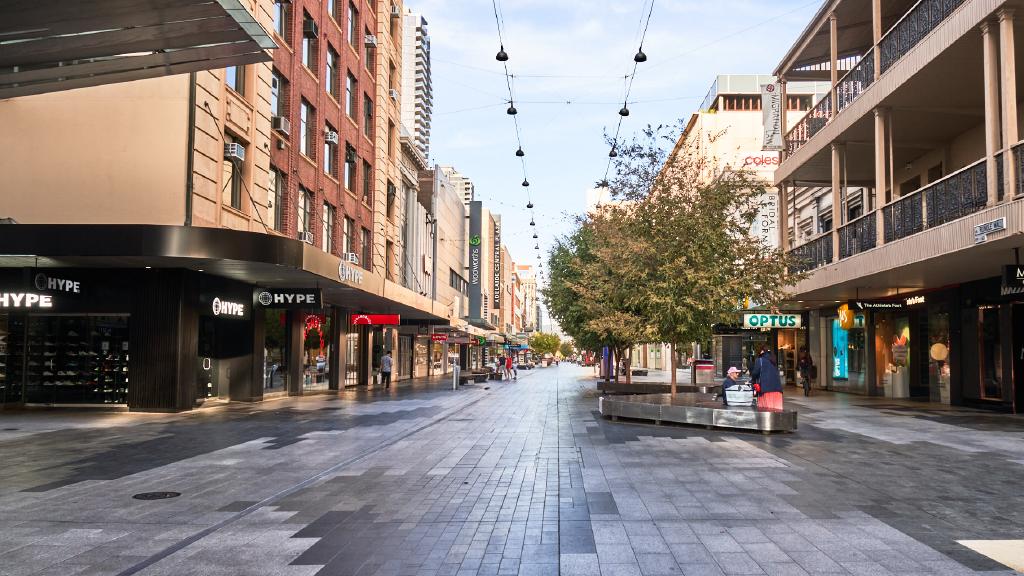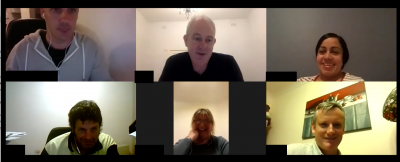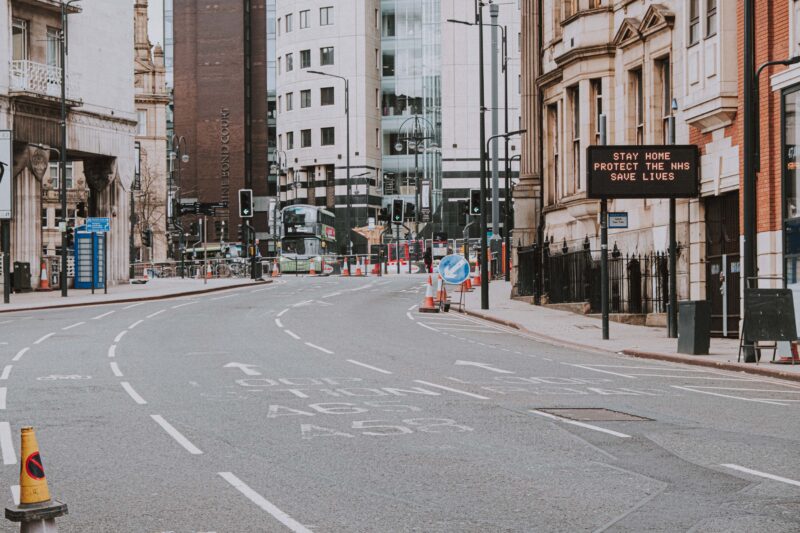Crazy times in retail
These are indeed crazy times, and we have seen shopping behaviours over recent months that have made many minds boggle. As retail restrictions softened on the weekend and shoppers responding hungrily from their retail starvation, it is worth reflecting on the recent months of isolation and its impact on retail. South Australian retail spend increased by a record jump in March, with some benefiting more than others from the pandemic. There have been interesting shopping patterns revealing much about consumer behaviour.
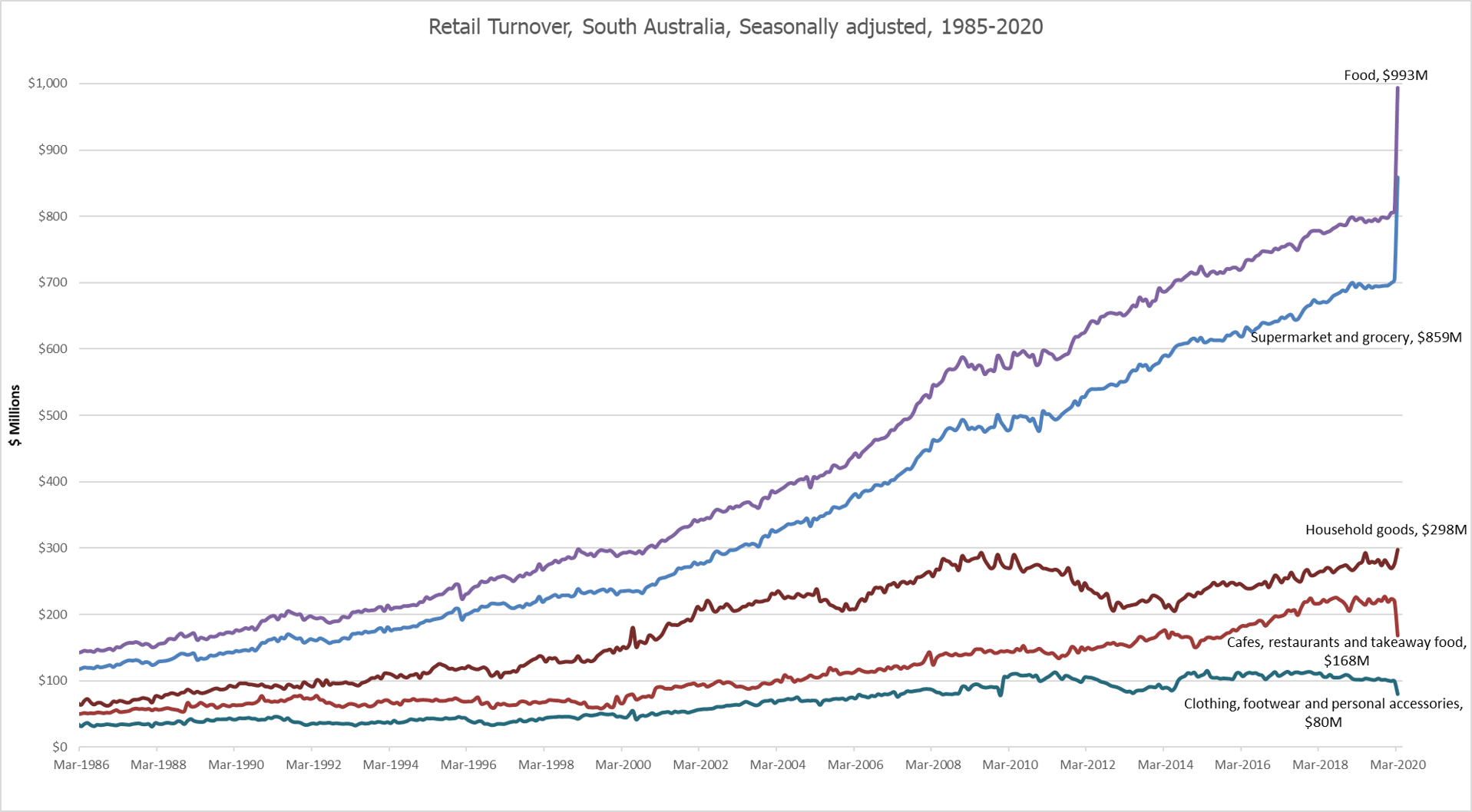
Supermarkets and food retailing attracted record growth in sales during March of around 22%. Cafés, restaurants and takeaway (down 23%) and clothing, footwear and personal accessories (down 20%) took the biggest hit.
These patterns are consistent with Australia overall, and particularly strong sales growth in March was seen in non-perishable goods (canned soup, flour et cetera) increasing by around 145%. Canned and dry mixed soup spend was up 180% in March, toilet paper and other paper products around 115%.
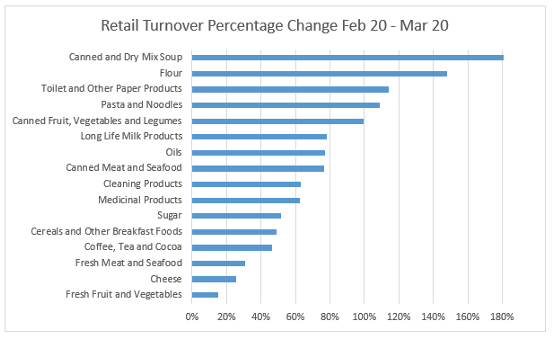
What is particularly interesting about these crazy times in retail, is that typically the rule of thumb is that spending increases when consumer confidence improves. What we have observed more recently is the community goes into PANIC MODE, human nature is for our survival instincts click in. As the apocalypse is feared to be approaching. Self preservation is a set of behaviors that ensures the survival of an organism. It is universal among all living organisms. Pain and fear are critical in self preservation, warning us of danger, and the need for protection. The instinct in humans and animals to do things in a dangerous situation that will prevent them from dying. A natural part of being a human.
COVID-19 stimulated the community’s innate survival mode. Consumer confidence recorded by Square Holes towards the end of March observed the lowest level since monitoring commenced in 2013. Those reporting to not be confident in the next 12 months jumped to 43% from 16% in October 2019. People stating they were confident dropped from 41% to 26%, again the lowest levels on record. Many feared the worst and responded accordingly.
As we headed into April, spending dropped back to more normal levels as South Australians adapted to staying at home and physical isolating. From Square Holes’ research, the panic subsided, and people felt less anxious and more comfortable, particularly as new cases in South Australia slowed. The dark tunnel of March, started to show a glimmer of light and less doom.
Square Holes’ confidence monitoring has illustrated an improved mood, with confidence in the next 12 months increasing from 26% in March to 33% in April, and unconfident declining from 43% to 30%. Confidence is well below the norm monitored in recent years, but there are signs of improvement.
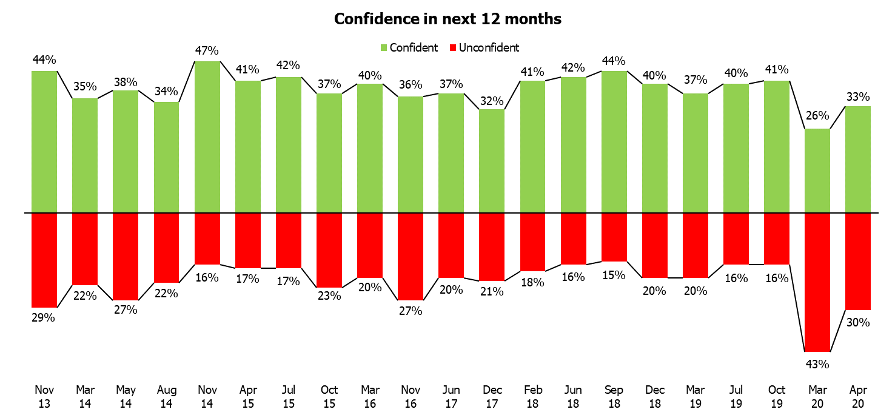
With this, financial security in 12 months time improved over the past month, although the community is feeling less financial security than 12 months ago.
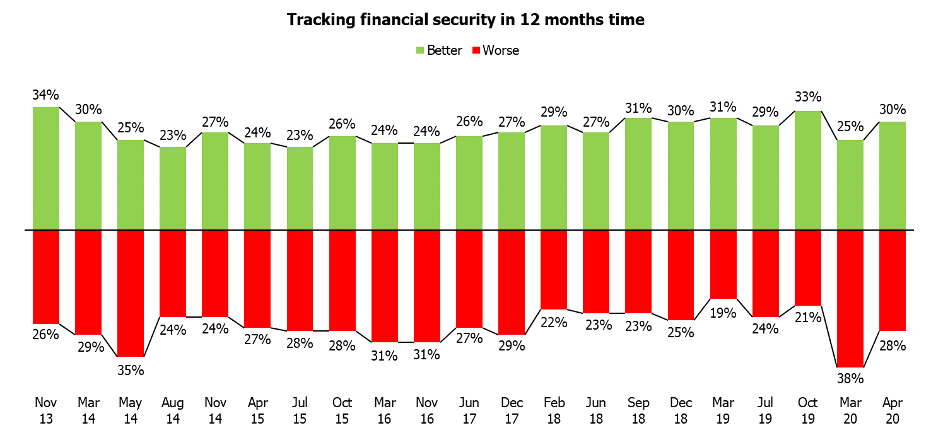
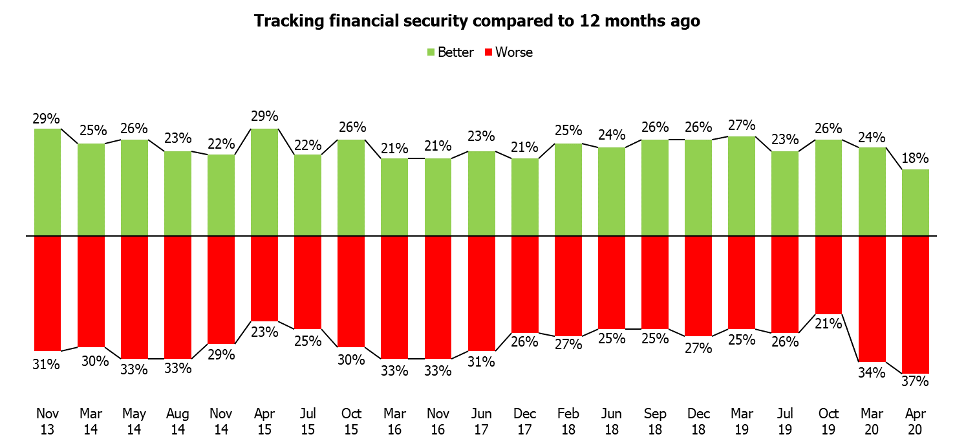
Square Holes’ survey at the end of April illustrated South Australians are continuing to spend more than normal in supermarkets, with many also spending more on takeaway and hardware, building and garden supplies. In saying this, a larger proportion are reporting they are currently spending less across categories than those indicating they are spending more. Quite logical when people a cautious of their own finances and economic conditions. The biggest declines were 62% indicating they are spending less at cafés, restaurants and catering than usual and 3% more, and 46% are spending less at department stores (online or otherwise) and only 3% more than usual.
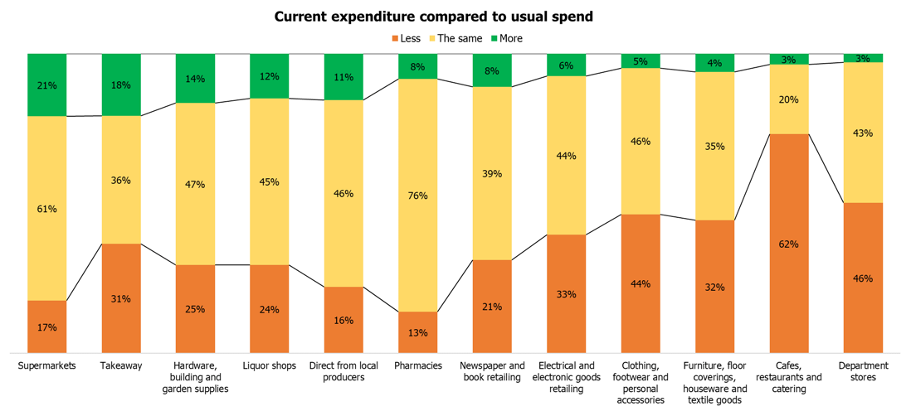
Some notable demographic differences include 34% of 30-34 year olds increasing their spend in supermarkets over the past month, 25-34 year olds noting the strongest increase in takeaway and 30-39 and 50-64 the big spenders in homeware, building and garden supplies.
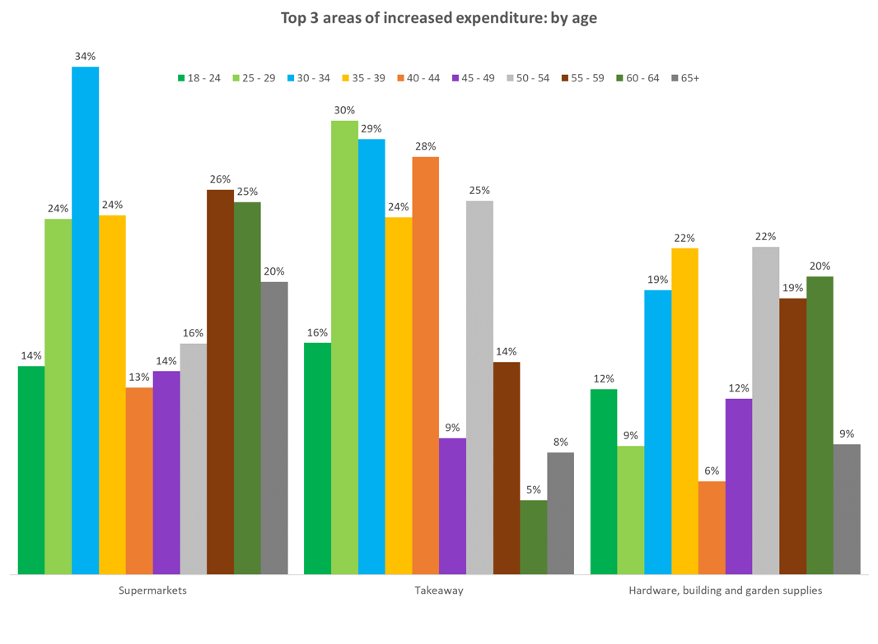
Many are experimenting with online, but for most they prefer to go to a store. Those who were spending more than normal in a category were asked if this was instore or otherwise. Online shopping is more common in categories such as clothing, footwear and personal accessories (63% online vs 28% in-store), and newspaper and book retailing (52% online vs 46% in-store). Click and collect is only used by around 8% of South Australians.
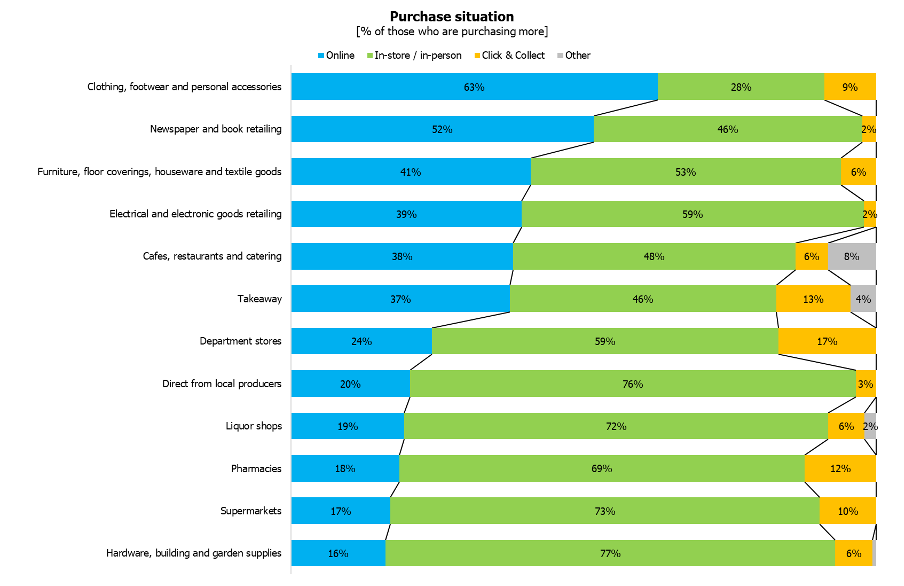
Overall there is a preference for shopping in-store. Likely as this is the habitual norm, what most shoppers usually do and are more comfortable with. There is, however, evidence that many people are currently experimenting with online shopping more often, and it is more common in some categories. According to Australian Bureau of Statistics figures, online shopping in Australia jumped by 23% in March compared with February, after both February and January noted falls compared with previous months. Online shopping represented 7% of total Australian retail turnover in March, equating to $2.07 Billion. With the success of online retailers such as Amazon Australia reporting Australian online revenue of $562 Million in 2019, this is sign of both opportunity and threat for retailers not responding adequately to such global retail juggernauts (More in this article ‘Amazon Australia nearly doubles its revenue but fails to turn a profit‘ Sydney Morning Herald March 16, 2020).
As the self-preservation apocolypitic consumer response of March subsided, many turned confessed and professed their focus to kindness and supporting local businesses impacted. While some have actually risen to the push to support local, many have not notable shifted their spending. While 16% of South Australians have increased how much they are spending shopping direct with local producers, 13% are spending less. Some age groups appear to be spending notably less, including 25-29 year olds.
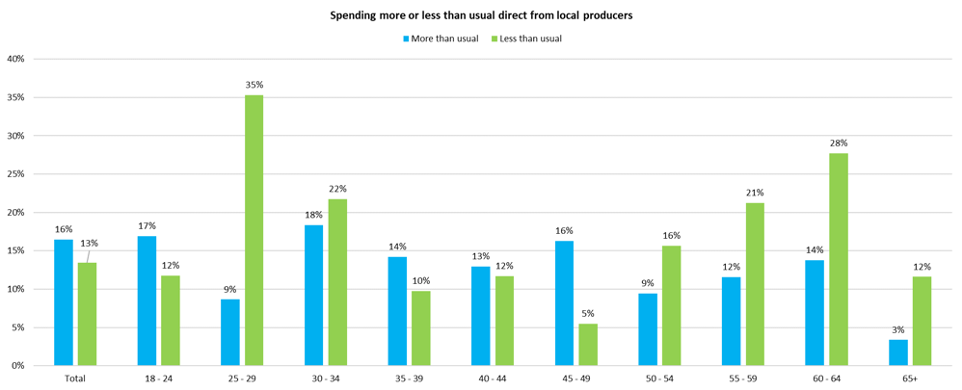
This may be from a preference to do so face-to-face rather than online, and perhaps many local producers do not have suitably enticing online stores. Of those who have increased their spending direct from local producers, 72% did so in-person. From Square Holes’ weekly mind and mood focus groups with different age groups of South Australians there is an intention to support locals, yet this is often not manifesting in actual purchases.
“I prefer going to the shops. If I buy wine, I tend to buy that online. But that’s the only thing. I go to the local greengrocer for my produce, and I don’t buy any green groceries from the supermarket. When I do go shopping, I always try to buy South Australian produce. Your Spring Gully, Maggie Beer. I think I’ll probably keep doing the same as I have been doing.”
SQUARE HOLES FOCUS GROUP PARTICIPANT AGED 70+
South Australia Tourism, through their initiative SATV, InDaily and it’s partners and others are working hard to profile local producers, and encourage the community to support local. There is value in continuing to make going direct to local producers more so default by offering attractive product and shopping experience online or otherwise.
The challenge for retail in these crazy times is to ride the waves and being ever aware of market trends and wider dynamics. Sectors such as cafes and restaurants are working hard to survive how best they can preparing for when restrictions start to relax. These are indeed challenging times for many hospitality businesses. Other sectors including clothing and books are in a fight against often more attractive and increasingly default options online, so there is a need to enhance their offering or close shop. Many retailers have failed to evolve, and are now facing very uncertain present and future survival. Particularly when household finances are anticipated to be tight for some time to come.
Not all retail is equal, nor lucky enough to be riding the self-preservation rush of supermarkets as they have evolved to essential service status, and with this face supply chain and other unprecedented complexities. Critical is that retail is ever evolving and so is the consumer. The future is uncertain, and the successful retailers will be those who move with the times, create the future and offer a strong value proposition for their online and/or offline store(s). Focusing on the things that will increase visibility and drive sales.
I will leave the final words to John-Paul Drake, Director of Drakes Supermarkets, he made in a podcast interview with me released last week on how to survive and prosper in retail.
“We have to be lean, and mean, without being mean to the customer. We are very selective in what we do. Very tactful in how much we are going to spend for the bang, for the buck that we get. For me, none of that has changed. We got really lucky we were on the front foot with COVID, with a couple of the thank you videos, and the latest ad supporting local.”
JP DRAKE
…
Square Holes is seeking a small number of partners in the mind and mood research we have been conducting to help make sense of the impact on South Australians.
More >
South Australia Mind & Mood
